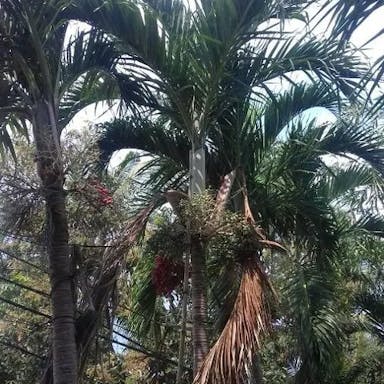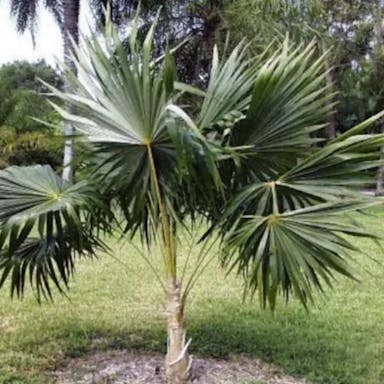Mexican blue palm, scientifically known as Brahea armata, is a striking plant characterized by its silvery-blue, fan-shaped leaves that form a dense crown atop a solitary trunk. This palm thrives in arid climates with well-draining soil. The small, yellow flowers of Brahea armata are clustered on long, arching inflorescences. When ripe, the fruit is black, round and small in size. This is considered a slow-growing species, reaching heights of up to 30 feet with a spread of 10-15 feet. Brahea armata is relatively easy to grow and maintain, making it a popular choice for Mediterranean and desert-themed gardens. It is also known for its drought tolerance and ability to withstand high temperatures.
Mexican blue palm
- Scientific name
- Brahea armata
Basic Information
- Arecaceae Family Brahea Genus Mexican blue palm Species
- Arecaceae > Brahea > Brahea armata
- 75%
- The Completeness of This Encyclopedia
Please help us complete the encyclopedia, Terrarium is a encyclopedia service to be completed with everyone in the world. Currently, this page is 75% complete. For more information on how to contribute, please click here.
- Palmae
- Tree
- Height
- 1000cm ~ 1500cm
- Flower Color
- Leaf Color
- Anthesis
- spring, summer
- Sunlight Exposure
Full Sun Long hours of sunlight from morning to afternoon Partial Shade A location in the shade of a tree or where either the morning or afternoon is shaded Full Shade A place where there is no direct sunlight
- Full Sun
- Hardiness Zones
This is an indicator to know to which zone each plant can winter. Knowing the zone of each plant gives you an idea of the cold temperature resistance when grown in the ground without a roof. 2: -42.7 to -40.0 3: -39.9 to -34.4 4: -34.3 to -28.9 5: -28.8 to -23.3 6: -23.2 to -17.8 7: -17.7 to -12.2 8: -12.1 to -6.7 9: -6.6 to -1.1 10: -1.0 to 4.4 11: 4.5 to 10.0
- 9
- Cold resistance
- Good
- Heat resistance
- Excellent
- Habitat of origin
- Mexico
- Growth Rate
- Slow
What is Mexican blue palm (Brahea armata)?
What is Mexican blue palm (Brahea armata)
Flower meaning
The flower language commonly used in America for the Mexican blue palm is: - Admiration - Strength - Loyalty One typical example is
Calendar of Mexican blue palm (Brahea armata)
Calendar
Mexican blue palm flowers spring summer. Late spring early summer best flowers. Blooms once year, lasts weeks. Sunlight, water, nutrients help longer blooms. Pruning dead fronds also helps more flowers.
How to grow Mexican blue palm (Brahea armata)
Watering
NO DATA
Soil and Fertilizer
Mexican blue palm performs better in properly drained soil. Neutral to slightly acidic soil works well. A combination of organic material and sand gives good results. Feed the palm with a slow-release balanced fertilizer twice a year - early spring and late summer. Spread the fertilizer around the base as per directions. Do not overfeed. Check soil regularly. Ensure it drains well and has nutrients. Test the soil. Know the pH level and nutrient content. Make changes if required.
Sunlight and Place
Mexican blue palm thrives in full sun to partial shade, preferring at least 6 hours of direct sunlight daily. It displays excellent heat tolerance but may struggle in extremely cold temperatures below 20°F (-6°C). During winter, protect it from frost by covering or moving it indoors. For optimal growth, maintain temperatures between 50-100°F (10-38°C). In summer time, provide a lot of water and make sure good water drainage. Avoid giving too much water to prevent root rotting. Place it in well-draining soil and think about using a slow-release fertilizer. Mexican blue palm's strength is in its ability to withstand intense sunlight, making it suitable for bright, sunny places. It is very important to check its exposure to sunlight to prevent sunburn. Regularly check for signs of stress like yellowing or browning leaves.
Advanced Information of Mexican blue palm (Brahea armata)
Pruning
Mexican blue palm requires action to cut damaged leaves. The better time is before new leaves start. To cut leaves use clean tools to cut at an angle to stop tearing. Take away any yellow leaves near the bottom of the plant. After cutting, put plant food on the plant to help new leaves start and give water fully. Don't cut too many leaves as it can worry the plant. Normal cutting helps the Mexican blue palm grow and look good.
Planting and Harvest
Mexican blue palm is best potted in well-draining soil with added sand for aeration. When planting, gently loosen the roots and place the palm in the center of the container at the same depth as it was in the nursery. Water thoroughly after planting and keep the soil consistently moist but not waterlogged. Repot every 2-3 years into a slightly larger container to accommodate growth. Mist the leaves sometimes to increase humidity, especially in dry indoor environments.
Propagation
Mexican blue palm can be propagated through seeds, division, or offsets. Division involves separating the plant into smaller sections with roots attached. Cuttings are taken from the stem or root, placed in the for division, and planted in a growing medium. Healthy leaves are taken, allowed to callus, and then planted in soil. To ensure successful propagation, use a combination of methods to increase the chances of success.
Pests and Diseases
Mexican blue palm is often found to have tiny arachnids, minuscule insects, and small sap-sucking bugs present. These very small creatures source food from the juices within the plant, making the leaves turn pale and stopping upward growth. To avoid groups of pests taking up residence inspection on a regular basis aids in early detection. Homemade sprays using gentle soap or neem extract can work when pests are spotted early. With fungal infections Mexican blue palm deals with small dark marks on the leaves or roots rotting leading to wilting and pale leaves. Appropriate watering by not oversaturating the soil and good drainage helps avoid fungal diseases. Eliminating and destroying plant sections showing infection stops the spread of the disease.
Habitat of Mexican blue palm (Brahea armata)
Habitat
Toxicity of Mexican blue palm (Brahea armata)
Health Benefits
- edible
- Inedible
- Toxic
- No toxicity
NO DATA
Toxic for dogs and cats
NO DATA
Q&A of Mexican blue palm (Brahea armata)
- Where can I find Mexican blue palm trees available for purchase?
Mexican blue hand trees, scientifically perceived as Brahea armata, are available at online plant stores and center gardens trading in foreign plants. These sites have Plant Delights Nursery, Logee's, and Amazon. Assure the merchant is good and gives thriving, cared plants. Also, neighborhood plant stores in zones with suitable climates, like Southern California or Florida, might carry this group. Recall to check particular care essentials for the Mexican blue hand to guarantee it will prosper in your exact spot.
- Is there a recommended way to choose?
The initial sentence remains unchanged. Mexican blue palm includes two kinds, one with silver-blue leaves and one with more blue color. When selecting the seedlings, healthy ones with good root systems are good. The seeds should be plump, firm, no mold, and high quality from reputable sellers. For the garden, you can pick silver-blue or intense blue varieties based on the look you want.












